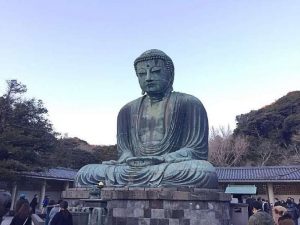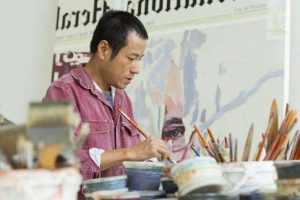From 27 September 2024 to 23 February 2025, the British Library in London is holding a new exhibition titled “A Silk Road Oasis.” Curator Mélodie Doumy spoke to Buddhistdoor Global about this landmark show, which falls on the year of the International Dunhuang Programme 30th anniversary. “A Silk Road Oasis” showcases a unique cultural convergence of diverse civilizations and peoples in a single town. As we peer into the past, with the manuscripts as windows to the everyday lives of nuns, merchants, artists, and families, we are treated to a survey of human relationships, hopes, and feelings through time that come together to make a uniquely emotive and relatable exhibit.
The International Dunhuang Programme, based at the British Library, is a pioneering global partnership that brings together online collections from the Eastern Silk Roads across more than 35 institutions.
Mélodie Doumy is curator of Chinese collections at the British Library, with a specific focus on the Stein Collection of Dunhuang manuscripts and the International Dunhuang Programme.

BDG: The museological experience of the exhibition is unique: the British Library team has structured the exhibition in several thematic sections that embody a certain character or personality who would have used the displayed items. How is this experience different from how life in Dunhuang, or on the Silk Road, has traditionally been depicted?
Mélodie Doumy: The exhibition adopts an individual-focused approach, contrasting with traditional depictions of Dunhuang and the Silk Roads that emphasize broad historical events. Instead, the show organizes objects around specific characters or personalities, such as the “scribe,” “merchant,” and “Buddhist nun,” allowing visitors to connect with the personal stories of those who lived in or passed through the oasis town.
The design emphasizes Dunhuang’s vibrant, multicultural atmosphere. While layered fabric sweeps suggest the surrounding desert, vertical banners represent the characters of each thematic section. Featuring colourful patterns inspired by the Mogao Caves’s murals, these banners give a sense of a populated street, with section names displayed in various languages to highlight cultural diversity. Booklet-shaped labels have also been created for documents linked to named individuals, fostering a sense of emotional connection with visitors.
To enrich this immersive experience, we also included recordings of five of the texts on display to allow visitors to engage with these on a deeper sensory level. Another key component is the specially commissioned soundscape that complements the exhibition’s content. Overall, the narrative structure, design elements and auditory components create a more dynamic and intimate exploration of ancient Dunhuang, making the experiences of its inhabitants feel tangible and relatable.

BDG: The Old Tibetan Annals are one of the only contemporaneous texts revealing the period of the Tibetan Empire. What do they tell us about the nature of the Yarlung dynasty, and anything about the first diffusion of Buddhism in Tibet?
MD: The Old Tibetan Annals are the earliest surviving historical sources on the early Tibetan Empire, which emerged in the seventh century on the Tibetan Plateau and grew into a formidable military power. The Annals provide a priceless insight into the structure and governance of the Yarlung dynasty, which reached its peak of territorial expansion in the late eighth century, extending as far as the Hexi Corridor.
The version of the Annals featured in our exhibition, known as the “civil version,” is primarily administrative, offering a detailed year-by-year account of events from 641–748 CE. It begins with the arrival of the Chinese Princess Wencheng in Lhasa to marry Emperor Songtsen Gampo, who is often credited with introducing Buddhism to Tibet.
Despite being written on the reverse of a manuscript of the Lotus Sutra in Chinese, this document is not concerned with Buddhism. It was probably produced in Dunhuang and copied from an original document from central Tibet. Its handwriting style is unique to manuscripts associated with the Tibetan imperial court, and its dating system was employed in official correspondence and contracts, underscoring its administrative purpose.
BDG: The Dunhuang star chart is famous for being the earliest extant astronomical map of any civilization. How does it influence our understanding of Chinese astronomy of the period?
MD: The Dunhuang star chart is an extraordinary document, dated to around 650–700 CE. It consists of 12 maps that represent the sky in 30-degree sections from east to west, aligned with the months of the Chinese lunar year. A 13th map illustrates the north-circumpolar region, which includes stars visible throughout the year. As the earliest known celestial atlas from any civilization, this star chart provides crucial evidence of the cultural significance and sophistication of astronomy in China in the Tang dynasty (7th–10th centuries).
In total, more than 1,300 stars are recorded and organized into 257 constellations, or asterisms. These were drawn in different colors, representing three ancient schools of Chinese astronomers: red for Shi Shen, black for Gan De, and white for Wu Xian. This classification reflects China’s long-standing tradition of systematically observing and categorizing the night sky. The accuracy of the star positions is remarkable, especially given that the telescope had not yet been invented. Even more impressive is that the 13 maps were produced according to precise geometrical rules, suggesting the use of projection methods like those developed in Europe during the Renaissance.
Each map is accompanied by explanatory text, naming the corresponding region of the sky, the astrological predictions associated with it, and the area of the Chinese empire thought to be influenced by those stars. This reveals the close connection between astrology, astronomy, and governance in ancient China, where understanding and interpreting the heavens was a task reserved for imperial astronomers. Such observations were believed to maintain cosmic order, with direct implications for political stability.

BDG: Many of the items center around an archetypal character who would have lived in Dunhuang, such as a document of government approval for a woman to be ordained as a nun, a fortune-teller, a scribe, and so on. Are there any characters that particularly resonate with you?
MD: One of the characters who particularly resonates with me is the diplomat who is known under different names: Zhang Jinshan in Chinese, and Ca Kima-sana in Khotanese. He was an envoy from Khotan, a Buddhist kingdom located 1,800 kilometers west of Dunhuang, on the southern edge of the Taklamakan Desert. He is linked to several documents in the British Library’s collection, two of which are featured in the exhibition.
One document is a vertical scroll in which Zhang Jinshan writes in both Chinese and Khotanese. Interestingly, his Chinese script runs left to right, influenced by his native tongue. In the Chinese section, he vividly recounts his devotional activities in Dunhuang, describing his pilgrimage to the Mogao Caves, where he lit lanterns, burned incense, and prayed to the Buddha. Below that, in Khotanese, he documents the 115-member mission that he led to Dunhuang to secure the hand of a Chinese princess for his king. On the back of the scroll, he inscribes yet another fascinating account—this time of an itinerary from Khotan to India.
Zhang Jinshan is also associated with a very important medical manuscript, which is a translation in Khotanese of the Siddhasara, a key ayurvedic medical text originally in Sanskrit and attributed to Ravigupta. He signed his name on it in yet another language—Sogdian, playfully navigating between several of the languages spoken in the region. Having myself grown up in a multicultural family, lived in different countries and studied international relations, I find his story fascinating. He was a polyglot of mixed heritage, possibly Sino-Khotanese, who disseminated geographical and medical knowledge.

BDG: What does the very multicultural nature of the items on display tell us about the historical interactions in the area?
MD: The items on display reveal the multiculturalism characterizing Dunhuang and the broader Silk Roads region. The manuscripts, written in Chinese, Tibetan, Sanskrit, Khotanese, Sogdian, Old Uyghur, and Old Turkic, reflect the area’s diversity, shaped by its history of being ruled by various empires and inhabited by a melting pot of people. A particularly striking example is the rubbing of the Stele of Sulaiman, where the mantra of Avalokiteshvara is carved in six different scripts.

Religious plurality was another defining feature of Dunhuang’s communities. While the town was deeply influenced by Buddhism, it was also home to a range of belief systems, such as Manichaeism, Zoroastrianism, Nestorian Christianity, and Daoism. A unique copy of the Xuastvanift, a key repentance prayer for Manichaean Uyghurs found in Mogao Cave 17, demonstrates that the significant presence of the Persian prophet Mani’s followers in Central Asia and China. Another very important text is the Ashem Vohu, a Zoroastrian prayer written in Sogdian in the ninth century. It predates any other surviving Zoroastrian scripture by 400 years!
Through the exhibition, we hope to foster a better understanding of Dunhuang’s historical interactions. It wasn’t just a hub for trade and diplomacy but a place where cultural, spiritual, and intellectual exchange thrived.

BDG: How important has collaboration with overseas institutions been for this exhibition? How important is overseas collaboration for the International Dunhuang Programme overall?
MD: International collaboration is central to the British Library’s mission of advancing knowledge and fostering mutual understanding, especially with organizations closely tied to our collections. This year marks the 30th anniversary of the International Dunhuang Programme. One of our key partners, the Dunhuang Academy, provided many of the stunning images featured in the gallery, helping us to visually connect the exhibition to the Mogao Caves and the broader region of Dunhuang.
As mentioned earlier, we also collaborated with the Sound Art Museum in Beijing to produce audio recordings of five key items in five different languages—Mandarin, Tibetan, Old Turkic, Sogdian, and Khotanese. The recordings bring the multilingual world of Dunhuang to life, enhancing the immersive experience for visitors.
In addition, we worked with the China Database for Traditional Music, the director of which, Wei Xiaoshi, created a rich, immersive soundscape for the exhibition. Connecting past and present through sound, this unique soundscape blends archival recordings from the British Library’s sound archive and the China Database for Traditional Music with contemporary works, including contributions from Tibetan folk artist Ngawang Lodup, Uyghur virtuoso Shorhet Nur, and Chinese musician Wu Fei.
Related features from BDG
Buddhistdoor View: Telling a History We Can All Resonate with through Dunhuang
Related blog posts from BDG Tea House
Mélodie Doumy’s “A Silk Road Oasis” at the British Library
The British Library’s “A Silk Road Oasis” – an ambitious story of the Silk Road’s finest textual treasures













